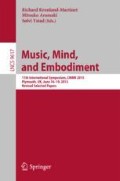Abstract
A key issue in designing personalized music affective applications is to find effective ways to direct emotion by music selection with appropriate combination of acoustic features. The aim of this study is to understand the dynamic relationships between acoustic features, physiology and affective states. To model these relationships we used a multivariate approach including continuous measures of emotions from behavioral, subjective and physiological responses. Classical music excerpts taken from opera overtures were used as stimuli to induce emotional variations across time between neutral and intense emotional states. Continuous ratings of arousal and valence along with cardiovascular, respiratory, skin conductance and facial expressive activity were recorded simultaneously. Results show that parts of the music with higher loudness and pulse clarity induced higher ratings of arousal, sympathetic activation and increased cardiorespiratory synchronization. In contrast, pleasant and calming parts with major mode and prominent key strength induced higher ratings of valence, parasympathetic activation and increased facial activity.
References
Gabrielsson, A., Lindstroem, E.: The role of structure in the musical expression of emotions. In: Juslin, P.N., Sloboda, J.A. (eds.) Handbook of Music and Emotion: Theory, Research, Applications, pp. 367–400. Oxford University Press, New York (2010)
Eerola, T., Lartillot, O., Toiviainen, P.: Prediction of multidimensional emotional ratings in music from audio using multivariate regression models. In: Proceedings of the International Conference for Music Information Retrieval (ISMIR) (2009)
Fornari, J., Eerola, T.: The pursuit of happiness in music: retrieving valence with contextual music descriptors. In: Ystad, S., Kronland-Martinet, R., Jensen, K. (eds.) CMMR 2008. LNCS, vol. 5493, pp. 119–133. Springer, Heidelberg (2009)
Trochidis, K., Delbé, C., Bigand, E.: Investigation of the relationships between audio features and induced emotions in Contemporary Western music. In: Proceedings of the 8th Sound and Music Computing Conference (2011)
Hodges, D.A.: Psychophysiological responses to music. In: Juslin, P.N., Sloboda, J.A. (eds.) Handbook of Music and Emotion: Theory, Research, Applications, pp. 279–311. Oxford University Press, New York (2010)
Krumhansl, C.: An explanatory study of musical emotion and psychophysiology. Can. J. Exp. Psychol. 51(4), 336–352 (1997)
Gomez, P., Danuser, B.: Relationships between musical structure and physiological measures of emotion. Emotion 7(2), 377–387 (2004)
Nyklicek, I., Thayer, J., Van Doornen, L.: Cardiorespiratory differentiation of musically-induced emotion. J. Psychophysiol. 11, 304–321 (1997)
Khalfa, S., Roy, M., Rainville, P., Dalla Bella, S., Peretz, I.: Role of tempo entrainment in psychophysiological differentiation of happy and sad music? Int. J. Psychophysiol. 68(1), 17–26 (2008)
Coutinho, E., Cangelosi, A.: Musical emotions: predicting second-by-second subjective feelings of emotion from low-level psychoacoustic features and physiological measurements. Emotion 11(4), 921 (2011)
Trochidis, K., Sears, D., Trân, D.-L., McAdams, S.: Psychophysiological measures of emotional response to Romantic orchestral music and their musical and acoustic correlates. In: Aramaki, M., Barthet, M., Kronland-Martinet, R., Ystad, S. (eds.) CMMR 2012. LNCS, vol. 7900, pp. 44–57. Springer, Heidelberg (2013)
Juslin, P.N., Sloboda, J.A.: Handbook of Music and Emotion: Theory, Research, Applications. Oxford University Press, Oxford (2010)
Lartillot, O., Toiviainen, P.: MIR in Matlab (II): a toolbox for musical feature extraction from audio. In: International Conference on Music Information Retrieval, Vienna (2007)
Rosenblum, M., Pikovsky, A., Kurths, J., Schäfer, C., Tass, P.A.: Phase synchronization: from theory to data analysis. Handb. Biol. Phys. 4, 279–321 (2001)
Van der Zwaag, M., Westernik, H.D.M., Van der Broek, E.: Deploying music characteristics for an affective music player. In: 3rd International Conference on Affective Computing and Intelligent Interaction and Workshops, Amsterdam, Netherlands (2009)
Acknowledgments
This work is supported by the SUTD-MIT International design center (IDC) Research Grant (IDG31200107/IDD11200105/IDD61200103). The authors thank Hải Lê Vũ for valuable technical assistance during the experiments.
Author information
Authors and Affiliations
Corresponding author
Editor information
Editors and Affiliations
Rights and permissions
Copyright information
© 2016 Springer International Publishing Switzerland
About this paper
Cite this paper
Trochidis, K., Lui, S. (2016). Modeling Affective Responses to Music Using Audio Signal Analysis and Physiology. In: Kronland-Martinet, R., Aramaki, M., Ystad, S. (eds) Music, Mind, and Embodiment. CMMR 2015. Lecture Notes in Computer Science(), vol 9617. Springer, Cham. https://doi.org/10.1007/978-3-319-46282-0_22
Download citation
DOI: https://doi.org/10.1007/978-3-319-46282-0_22
Published:
Publisher Name: Springer, Cham
Print ISBN: 978-3-319-46281-3
Online ISBN: 978-3-319-46282-0
eBook Packages: Computer ScienceComputer Science (R0)

